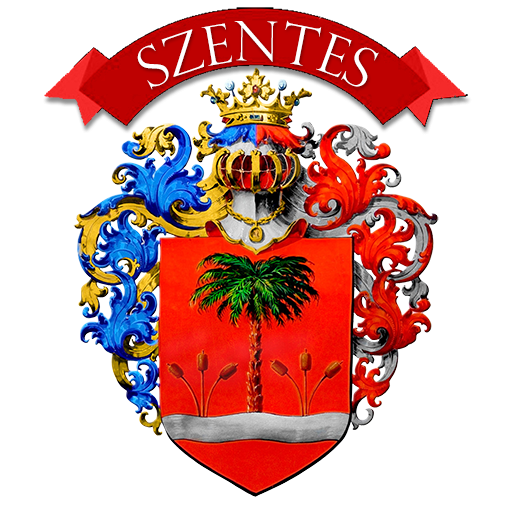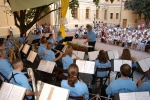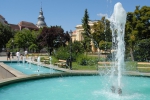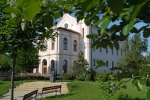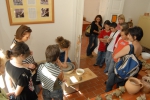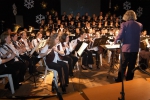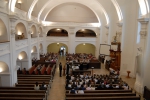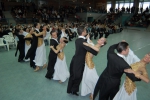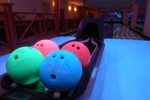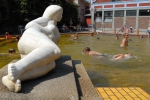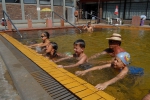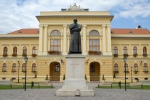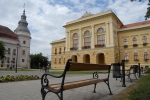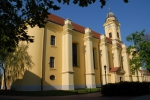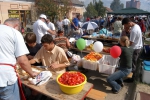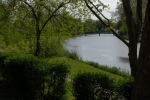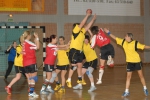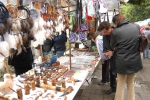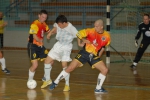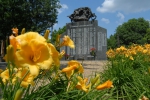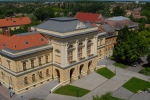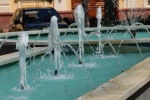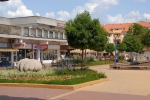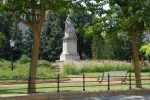Attractions
Introduction
Szentes with its 30.000 inhabitants is the third most populous settlement in Csongrád County. Situated in the South East of the Great Plain it is very lucky not only because of the high number of sunny hours, but because its richness in thermal water.
Szentes is located near the Tisza, the second biggest river of Hungary. The small but youthful town receives the representatives of economy, sports, culture and tourism with a warm welcome; it is open for the other people and takes pride in showing its own values. Szentes is bound up with several Hungarian and foreign settlements thus making it possible for their inhabitants to co-operate with each other in all parts of life. Based on the outstanding activity between the sister-towns, personal exchange programs, effective charity works and the town’s European intellectuality, Szentes received the European Diploma and the Flag of Honour. In addition to this, in 2009, it was awarded European Plaquette, the Council of Europe’s second highest ranking award. On 13 April 2010 the Minister of Education and Culture has given the „Town of Statues” title to the town. As the townspeople lead a very active life in 1996 ‘National Sports Town’ title was awarded to Szentes. The most significant sport in the town is water polo but the members of various dance clubs have also achieved outstanding results just like the sportsmen of Kyokushin Karate club who became multiple Hungarian Champions. The town raises Hungarian-, European and World Champions in other combat sports as well, and in many other sports it is the most important centre of the rising generation.
| A nyilakkal körbe tud nézni Szentesen! Nagyítani a numerikus billentyűzet + és – gombjával lehetséges! |
The Local Government of Szentes has been making remarkable efforts to restore the most significant buildings of the town and to reconstruct its squares and parks. It is very important that the buildings and monuments that dominate the townscape should be functional and also commanding in their appearance. As a result of this effort the old County Hall has been renewed that is functioning now as a Conference Centre and became the home of the Archives and the Koszta József Museum. Szent Miklós Square and Kossuth Square, the latter is the biggest square of the town, were given a new design, Nagy Ferenc Street became a pedestrian area, and the Great Reformed Church was restored just like Kiss Bálint Street. All these helped to create an attractive townscape that welcomes visitors. The reconstruction of Hotel Petőfi is proceeding and its importance lies not only in its central location but because it will greatly expand the town’s accommodation capacity.
The orderly parks, swimming pools and sport fields offer excellent facilities for relaxing to young and elderly, and the magical effects of the town’s thermal spa, the silence of its museum and art gallery are all waiting to be discovered. The tourism of Szentes is enriched by the bustling cultural life, architectural work of arts and its natural environment. The attractions of the surrounding towns and villages, the programmes in Szentes, foreign connections of the big companies, the town’s developed agriculture and last but not least the partnership towns prove Szentes’ significant activity in Europe and its twisting development. The most popular programs of the town are: the Winter Farewell Carnival, held every year in the last weekend of February, the Cultural Festival and Walking with Chinese lanterns on 30th April, the Kurca Regatta, that is in the middle of July, Saint Stephen’s (Szent István) Days on 20th August, the Letcho Festival, held in the first weekend of every September and the Square Festival also held in September, usually in the third weekend.

The Széchenyi Grove and the Csallány Gábor Exhibition Place
We start our trip in Széchenyi Grove, the ‘island of experience’, where, apart from thermal, experience, swimming and children pools, slides, playgrounds and tennis courts, peaceful green area is waiting for the visitors. Széchenyi Grove is located in the heart of the town about 500 meters from the town centre. The grove that is girdled with the channel Kurca is one of the most beautiful creations of the town which was completed in 1869. Part of the grove was turned into a botanical garden and we can find sycamore, white and red linden, white birch, catalpa, white horse-chestnut tree, cornelian cherry etc. among the trees. In 1894, as a result of reorganization, the park was expanded with different pine trees. In 2010, during the reconstruction of the park, more than 3000m2 area was turned into a lawn and about 1000 pieces of arboreal was planted by the Local Government. The 50 most typical bushes and tree types in the park are marked with botanic signs. The park, with its 7 acres located in line with Csongrádi Street and with the Kurca flowing around it, is a nature reserve and it is also the most important area of the tourism of Szentes. A 100 years old sycamore alley is lining along the Kurca to the entrance of the swimming pool. At the entrance of the park there is a World War II monument (by Máté István in1989) and a Széchenyi- column (by Pataki Sándor wood-carver). As we go along the Kurca towards the swimming pool first we can see the building of the ex- Turkish bath that is now functioning as a Family Help Centre. It was built in 1869 in Classicist style. In the beginning it was used as a Turkish bath later as a salty bath. When we move on towards the centre of the park we can glimpse at Csallány Gábor Exhibition Hall of the Koszta József Museum. The building that originally functioned as a restaurant was built in Classicist style in 1869 and since 1949 it has been a museum. In front of the main entrance, the Paris Grand Prix winner Navvy Statue by Borbereki Kovács Zoltán is erected to commemorate the brave navvies working on the continual archaeological excavations. In the garden of the museum the Zsoldos-Well (1891) commemorates the most important industrial dynasty of the town. Behind the building of the former Turkish bath there is the open-air artesian swimming pool which was opened in 1896 and has been the most popular place among young people ever since.
Szentes Holiday resort
If you want something different than the crowd of the posh holiday resorts Szentes is a perfect place to spend a few days with your family in quiet and peaceful surroundings near the waters. The open-air summer artesian swimming pool, behind the building of the Turkish bath, was completed in 1896. The swimming pool or strand, as Hungarians say, is a perfect place for passive and active holiday makers as well. Thermal pools, sauna and bubbling baths are waiting for those who like resting in calmness; for sportsmen swimming pools and slides are offered, and for the smallest ones there are two paddling pools with mini slide and babble. The holiday resort is the home of the various swimming competitions, water polo matches and festivals. It is also possible to rent water bikes and boats, to play mini golf, badminton, foot tennis and basketball or beach volleyball; angling and night swimming linked with movie watching. Intimate brick and wooden bungalows provide accommodation for the guests but it is also possible to camp in tents or caravans. There are snack bars lining along the partly covered dining area and Liget Restaurant is inviting the hungry guests opposite the tennis courts. The swimming pool’s services are also available in wintertime because the 25 and the 33 meter swimming pools are covered with a tent and the outdoor swimming pools are filled with hot thermal water. Only the people of Szentes know the word ‘brűg’ which means the unforgettable experience of enjoying the hot thermal water outside in winter, occasionally in the snowfall. Szentes gives perfect opportunities from the young to the old to remain healthy or to recover from an illness whether alone or with family. Apart from expanding the services of the Holiday resort and experience pools in Széchenyi Grove a new area will be joined in the tourism that is connected to the swimming pool along the channel Kurca. The realization of the planned hotel, adventure and Fairytale Park and the so called Kurca Plage that is framed in the area of the Holiday resort will give new dimensions in the tourism of the town.

The first tennis court was created in 1897, especially for the pleasure of the high society of the town. Today there are 15 tennis courts; two of them are covered in winter. As we go along the Grove towards the Kurca we can see the swimming fountains with their 9 meter high water-spout which help to improve the river’s oxygen-supply. The two floodlit fountains give a spectacular sight at night that is unique in the country. The only similar fountain can be found in the Lake of Geneva in Switzerland (with a 150 meter high water-spout). The Esperanto Bridge is also in this reach of the river. The 1.5 meter wide and 45 meter long, wooden pedestrian bridge that stands on 24 oaken piles was built in August 1981 and it connects Kisér (the Lower part of the town) with Széchenyi Grove. The name of the bridge commemorates the National Esperanto Peace Meeting held in Szentes in 1982. The Esperanto Bridge had a complete reconstruction in 2010.
Dózsa House and the sport fields
Dózsa House with the sport fields, the former handball court and the bike-and skate-park are located on the other side of Csongrádi Street.
Dózsa House was built between 1932 and 1937 in neo-romantic style, based on the plans of Antal Endre és Dobovszky József István. It was constructed by Vitéz Orgován János bricklayer from Szentes. The enormous oak standing in front of the building was planted at the time of the construction and a National Flag Pole was erected in 1942. In 2002 the building was restored with the help of the Local Government. At present it functions as a training hall for dancers and as a kayak-canoe renting place but the eastern side will be rebuilt where a Civil Community Hall will be formed by the Family Help Centre. In 1996 Szentes won the title ‘National Sports Town’. At that time it was possible to pursue a sport in a very high level as all the circumstances were ensured. Since then the different sport branches have gone through a very rapid technical development that needed to be followed and many new sports have come into existence like extreme sports. To be able to practise a Skate Park has been made which was opened in 2010. The high quality park is a popular place where more and more young people can skate or ride their BMX. The Sport Centre is planning to develop the area into an alternative leisure centre which would also include an open-air basketball court, a youth club and would provide cheap accommodation for the young. When we go about 2 kilometres along Csongrádi street, that leads out of the town, we can find the Tisza River with its sandy beach which offers a special summer experience for visitors and hundreds of locals too. Opposite the Tisza beach is the Water Administration Museum that displays the still working machines of the 19th century water environment with steam machines and other technical appliances. To reach this museum and the beach of the river we can enjoy the comfortable way of a cycling road that begins at the entrance of the Széchenyi Grove.
Elisabeth Square
Szentes, with its squares opening into each other, opens the hearts and connects the people. Walking over the first stone bridge of the town, from the direction of Csongrád, we arrive at the square formed in 1914 and named after Queen Elisabeth. It was originally called Holy Trinity Square because of the Holy Trinity Statue (by Joblonszky Vince, 1886) situated in the western part of the square. The square shaped, plinth of the limestone statue is on a mount (with three steps) that was newly carved around 1980. On the four sides of the statue there is a pedestal holding a squared column with the Holy Trinity monument. On the sides of the column the statues of the four evangelists can be seen: in the front St. Mark, on the right St. Luke, on the left St John and behind them St Matthew. The square is surrounded by the Town Court, the St Elisabeth Catholic Primary School, the St Anne Roman Catholic Church and Presbytery and the side wings of the Town Hall and the former County Hall. In the middle of the square is the memorial of the heroes of the First World War (Pásztor János, 1926). On the south side is the St Elisabeth Catholic Primary School built in 1912 in Hungarian art nouveau style with a balcony and fleche on the façade. On the west side of the square is the building of the Town court (1911) which is linked to the catholic presbytery (1937) by arcades. The first Hungarian Royal Court began to operate in 1872 in a building rented from the town. The new building of the town court, built in art nouveau- eclectic style by Dobovszky József István local architect, was built on the place of the former building of the police. The two-storey, villa-like building was completed in 1911 but the offices could only move into it in 1912. On the composite entablature there was a mosaic coat of arms with the inscription “Hungarian Royal Court” but later when the building was whitewashed and the mosaic was removed.
Saint Anne Church
On the corner of St Imre Street that runs into Elisabeth Square is one of the most significant buildings of the town, the Roman Catholic St Anne Church. Apart from one tower the baroque church, built between 1764 and 1768, was demolished in 1844. The church acquired its present neo-classic form in 1847. During the build up the tower had another storey and it was completed in late neo-baroque style. The façade was fronted with circular head of windows. In the niches of the main façade the statues of St John and St Peter can be seen (1768). The most significant work of art inside the church is the altar and chapel of Suffering Mary (1852) left of the entrance, under the chancel. The main altar was erected for the glory of St Anne, the patron saint of the church. The painting of the main altar shows St Anne teaching little Mary for the Ten Commandments. The front painting shows St Stephen offering the Hungarian crown to Mary. The candleholder next to the main altar was made around 1800. There are two bye-altars on the two sides of the arch the triumph presenting the Holy Trinity on the left and the engagement of Virgin Mary and St Joseph on the right. The statue of Suffering Mary was made in 1886; the statue of St Anthony and the Crosswalk in 1892 and the statue of St Theresa were made in 1932. The art-nouveau style seccoes of the ceiling were painted by Endre Béla and Rudnay Gyula in 1910. The presbytery’s mosaic-like painting depicts the Annunciation, in the other pictures there are episodes from the lives of Jesus Christ and the Wise men. The secco of the arc the triumph: ‘Hungarian Saints’ reverence in front of the Eucharist’ is the work of Terney Béla, 1949. The organ (Rieger) has 18 main and 7 side pipes and it was made in Pécs by Angster József in 1889. Among the furniture of the church we have to mention the priest’s seat from 1760, which was made in baroque style with velvet cover and the wooden parts are gilded. The oak benches ornamented with shell carvings were made by Antal János (1846-1850). The open, neo-classical confessional is the work of Tar János (1892). The vestry was made around 1820. From the liturgical equipments of the church a vestment is significant from 1763, which is embroidered with pearls and roses, and the double coat of arms of Baron Harruckern Ferenc and his wife Diriing Mária Antonia is also embroidered in it. The church is home of various concerts. In the garden of the church the statue of St Joseph can be seen that was erected by Mrs Kiss in 1891.
Horváth Mihály Grammar School
The eclectic styled two-storey main building of Horváth Mihály Grammar School, which has a great history, was built of brick after Benkó Károly’s design in 1888 then, between 1915 and 1918 it was enlarged with flanks after Ybl Lajos’s design. The grammar school, which has been operating since 1859, is the most tarnished secondary school in Szentes. Its high standard language training and the special drama class which was founded first in the country made the school famous. In the assembly hall there is the life-sized portrait of Zolnay Károly who was a former headmaster and the organiser of the local secondary school system. In 1922 the eight-year grammar school was named after Horváth Mihály historian, the bishop of Csanád and the Minister of Religion and Public Education who was born in Szentes. Inside the school building we can see some former teachers and students’ memorial places such as Greskovits Péter alpinist’s embossment, Dr Négyesi László and Dr Barta János famous literary historians’ memorial plaques, and the triplet embossment of Zolnay Károly headmaster – the founder of the school – Derzsi Kovács Ferenc and Derzsi Kovács Jenő teachers. Outside, on the façade of the main entrance Dr Brusznyai Árpád the school’s former student’s plaque was placed in 1991 that died martyrdom in 1956. On the other side of the street is the Rendezvous Well of Máté istván (1991).
The Olympic Oak
As we walk along Szent Imre Herceg Street we arrive at the corner building of Petőfi Sándor primary School which used to be a Civil Girl School. The school was built after the plans of Bohn Alajos in 1912-13 in eclectic style. The main entrance is shaped as a tympanum with four round stone columns. In the entrance hall the school founder headmaster Papp Lajosné Gonda Júlia’s (1869- 1964) plaque can be seen that was placed by Csallány Gábor Circle of Friends of Museum in 1994. Downstairs and upstairs the corridors are decorated with pictures depicting the history of the school. On the façade of the main entrance is the plaque of the school’s first pioneer group formed in 1957. In front of the school, where Szent Imre herceg and Petőfi Sándor Street cross each other, stands the Olimpic Oak. Lőrinc Márton wrestler won the Summer Olympic Games of Berlin on 9 August 1936 in light weight. As he could not plant the English Oak (Quercus Robur) in his home village in Transylvania (Romania), Lőrinc offered it to Szentes, and planted here in 1937. The National Sports Town is very proud of the tree and takes good care of it.
Péter Pál Civic House Museum
At the corner of Petőfi Sándor and Iskola Street is Péter Pál Civic House, built around 1830 in classicist style with columns, and is the early example of brick buildings in the Great Plain. The house that has a beautiful garden and a cellar functions as a guest house as well. Among the collection of Péter Family’s everyday objects and documents civic documents of Szentes from between 1836—1945 are displayed here. Apart from the civic collection there is a medical history collection in the main building and musical instruments, textiles are also on display. Szendrey Ignác, Petőfi Sándor’s (the great poet of the 1848-49 revolution) strict father in law, had also spent a winter here in 1851 as the steward of the manor of Nagymágocs. Legendary scarcity of the exhibition is the great poet’s (Petőfi Sándor’s) cradle which was rocking here for a few days. In the yard of the building the local historic stone relics are exhibited which need to be restored. The front of the house that faces Petőfi Street has a cellar where the wine of the stewards was kept. The cellar is very unique in the Great Plain with its through vault made of brick that was burnt in Szentes. The restoration gave an exemplary emphasis on the clear elements of bricklaying techniques.
The House of Arts
The House of Arts is situated in the heart of the town next to Petőfi Hotel that was built in Hungarian art-nouveau style and it is run by Rainbow Basic Art School (Szivárvány Alapfokú Művészetoktatási Intézmény).The house was built around 1840 and until 1952 the richest citizens of the town owned it. In 1968 it was declared as a protected building. In the past decade the farthest chimney was occupied by storks that came back year after year to their nest so the people of the town call the house ‘Stork House’. In 2006 Szentes and its sister town Újszentes won a tender and from this money the house was restored to its original state thus becoming one of the most significant buildings of the town. The House of Arts offers wide range of cultural choices on a very high level. Its main task is to collect living handicraft traditions. Different exhibitions show the local handicraft’s present and past for the visitors, the works of those trades people who keep hundreds of year’s traditions alive. We can look into the workshops of the certain crafts and with the help of experts we can try their tools and learn different techniques. Apart from exhibitions the house is also centre of the documents of those crafts that are dying out. Together with Koszta József Museum they have set up a program series linked to the special days of the calendar for example: Christmas, Easter, and Pentecost. The House of Arts is also home of exhibitions, dance houses, theatre performances, basic art training and adult education of high standard. The closed yard and the main hall of the building is an ideal place for family, friends or business programs. Outside the building the work of Börönte László, local sculpture, can be seen presenting arts and craft works
Kossuth Square

At the end of Petőfi Sándor Street we arrive at the main square of the town, which has borne the name of Kossuth Lajos since 1892. The most beautiful public buildings of Szentes are situated around the former market place. Kossuth Lajos – accompanied by Jókai Mór and Vasvári Pál – drove through the present Ady Endre Street to the old County Hall on 1st October 1848. His statue by Tóth István was placed in 1934 to the south-east part of the square where Kossuth held his speech that had a great impression on the people of the town. The statue was later (1974) put in front of the old County Hall and finally, during the reconstruction of the square, it was placed in front of the Great Reformed Church. At present the statue of Horváth Mihály – the historian Bishop – (Kisfaludy Strobl Zsigmond, 1934) is standing in front of the old County Hall, just like in the 1960’s. The main building of the western part of Kossuth square is the commanding neo-renaissance building of the former County Hall (Makay Endre, 1883.). On its composite entablature the county’s oval coat of arms is to be seen with the statues of Justice and Minerva. On the arches of the large windows there are allegoric female figures symbolising different trades; from the left to the right agriculture, home-industry, shipping, hunting, trade and fishing. Today the building houses the Archives, the Koszta József Museum and it also functions as a conference centre. Formerly the town’s first artesian well (the third in the Great Plain) bored in 1885-1886 (Zsigmondi Béla) used to be in front of the County Hall. The well (312 meter), which was ornamented by a five-statue group that came from France, was demolished in 1934 but in 1996 the Local Government rebuilt it in Luther Square.
The Town Hall
The southern side of the Kossuth square is dominated by the Town Hall with its mansard roofed façade and a corner turret. The Town hall was built in 1911 according to the plans of Bohn Alajos architect who was born in Arad. (Dr. Mátéffy Ferenc mayor was the head of the building committee). The most important construction works were made by trades people of Szentes. The building that was built in neo-baroque style is lining Kossuth and Elisabeth Square with its two mansard roofed facades and it is joined by a 37 meter high round corner turret that includes the main entrance with oval windows and columns. The main staircase that is moderate in decoration diverges towards the two wings of the building. On the second floor is the old Kossuth bust (1898). The Assembly Hall with its gilded, baroque style stuccos and gallery is very different from the simple offices of the building. The Hall is decorated by the painted portraits of the former mayors of the town, the life-sized portrait of Kossuth Lajos and the cast model of Petőfi Sándor and the town founder Baron Harruckern János György’s bust. The meeting rooms and offices are decorated by the works of local artists: Halász Szabó Sándor, Katona Kiss Ferenc, Tokácsli Lajos, Berkecz István and many others. The façade overlooking the Kossuth Square is decorated by the town’s coat of arms made of colour majolica (replaced in 1989) and a plaque commemorating the year 1836 when the town was freed from the feudalist system.
Koszta József Museum
The main building of the western part of Kossuth Square is the commanding neo-renaissance building of the former County Hall (Makay Endre, 1883). Today it functions as a conference centre and home of the Archives and Koszta József Museum. The documents which contain information on Csongrád County, Szentes town and the old districts from the 18th century hitherto are preserved in the Archives and there is also a great collection of maps, posters and photographs. The earliest documents were placed in the store of the building in 1884. Apart from official work, the institution also helps in public education and cultural life. Elementary and secondary school teachers regularly hold consulting and irregular history lessons. Every year dozens of university students and expert historians visit the museum to collect records for their thesis. Their research is helped by the library (containing 13,000 historic books) and the press collection where all the old, local newspapers and the most important historic magazines can be found either in its original form or on microfilm. The permanent and temporary exhibitions of the museum display a large scale from the past until today. The most significant permanent exhibition of the museum is dedicated to Koszta József, the great painter of the town. There are also permanent ethnographical exhibitions about the life of Szentes throughout the centuries, its agricultural life, the different parts of the town and its religious denomination, the different trades and the flourishing fine arts of the town in the past and present. The exhibitions of the museum, and the programs linked to them, are important elements of the tourism of Szentes and its surrounding settlements. They give great opportunity not only to guided groups but for families as well.
The Great Calvinist Church
The northern side of the Kossuth Square is dominated by the beautiful early neo-classic Calvinist Church (1808-1826). The lower part of the tower – built in 1774 – has a round balcony that was used for fire observation. The church is one of the biggest in Hungary, it has the longest nave in the Great Plain and it is the town’s biggest building with its 3500 people holding capacity. The country’s only original and still working Angster-organ is here made by Angster József and his son, two masters from Pécs. In the place of the medieval church that burnt down in 1760 the reformed church built a new church according to the plans of Fischer Ágoston between 1808 and 1826. Kiss Bálint pastor also helped the master who came from Kecskemét and today the church belongs to the biggest churches of Hungary. The more than 40 meter tower is in classic style while the other parts of the building are built in late baroque style. The main entrance is stone framed with arch lintel construction. Near the tower’s blunt corners there are stanchions running. Above the basket arch there is a round protected by iron balustrade. The tower is covered by a stilted, ribbed, copper bell-dome. On the northern facade between the stanchions segment arch windows can be seen. The southern façade was strengthened with a line of 7 stanchions in 1891. The west end of the church follows a straight line with blunt corners and double-wing door crowned by segment arch lintel in the main axis and with a tympan above the crown cornice. In the 48 x 24 meter inner area there is an asymmetrical balcony on the north side of the nave and on its two short ends. The balcony’s parapet is decorated with festoon in “copf” style. The asymmetrical space is covered by two huge and two small domical vaults. The walnut pulpit was made in late “copf” style with gilded ledges and polished surface and with greyish blue marbled supports.
Among the church equipments there are 18th century arts and craft works: tin lamps and pots, cup and cover for the communion table. The clock on the spire – bought by the town – was made by Rauschmann horologist and set up by Kari Vitus in 1828. According to the tradition, this was the second horizontal clock in Hungary; the first was in the castle of Archduke Joseph, Palatine of Hungary in Alcsút. As a result of the exemplary co-operation of the clergy and the Local Government the church has been completely restored by 2008 and today it can be visited in its original splendour. Apart from religious ceremonies there are organ concerts and exhibitions here. Its exceptional acoustics allows classical- and pop concerts to be held as well.
Kiss Bálint Street
Kiss Bálint Street – former Templom köz (Church Alley) – -starts behind the Calvinist Church. Many of its buildings are preserved (Nr.1-12.). The name comes from Kiss Bálint (1772-1853) pastor of the Reformed Church, Renaissance man of his age, excellent naturalist. Number 2 is the classical, one-storied, villa-like Calvinist Vicarage with a veranda and high roof. (1836, Navaro Ferenc) This was the shelter of Vörösmarty Mihály (the great Hungarian poet) during the absolutism. After the reconstruction of the former Calvinist Apartment House (1887-88, Makay Endre) it functions today as the Old People’s Home of the Reformed Church. Its classical look perfectly matches with the style of Kossuth Square. The secession style building of number 8 with its brick decoration is the former Reformed Congregation (1906, Borsos József) where the old records and religious documents of the Reformed Church of Szentes are kept. Today it is the Reformed House of Prayer. In front of it the gypsum head sculpture of Kálvin János can be seen, made by Koncz sculptor of Szentes. The former service homes of teachers and choristers are also in this street. The buildings – apart from two – are all remained in their original forms. With the reconstruction of the street an original 19th century picture of Szentes bursts upon the view of the visitors. Kiss Bálint Street is closed by the commanding building of Lajtha László Music School, built in 1892-93 in early eclectic style that functioned as a casino until 1944.
Tóth József and Sima Ferenc Street
When we turn back to Elisabeth Square and walk north towards Tóth József Street, we can find the house, next to Kiss Bálint Calvinist Primary School, where Boros Sámuel the first Mayor of the town lived. The house is more than 200 years old and it used to be the home of the all-time judge of the town until it was given to the Mayor. On his recruiting tour Kossuth Lajos spent a night here in October 1 1848. According to contemporary letters it is presumable that Vörösmarty Mihály, our illustrious poet, and Bajza József, his brother in law, were also here as guests. Today the historic building is called Szin-es Vendégház and it functions as a guest house with five rooms. Tóth József the most significant dramatic actor of the past century was born in the one-storey building of 26 Tóth József Street. He was the member of the National Theatre from 1850 until 1867.
Thermal Baths
On the corner of Ady Endre and Sima Ferenc Street is the Thermal Spa, based on the model of Turkish baths. It was designed by Dávid Károly (1962) who was the designer of the Sports Stadium of Budapest. The temperature of the water under the dome is 35 °centigrade. The big swimming pool is surrounded by 4 smaller ones with different water temperature. The baths are supplied by the thermal well of the nearby hospital bored in 1957. The water comes from 1735 meter and its temperature is 71° centigrade. The medicinal water is suitable for the treatment of joint disorders, rheumatism and chronic gynaecological diseases. Apart from the different water -, and electro therapies there is a sanatorium functioning in the Baths with 15 beds. On the side of the outdoor swimming pool the sculpture of a female act by Segesdy György (1963) can be seen.
